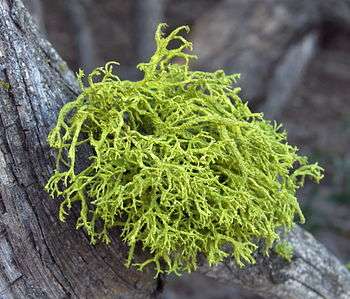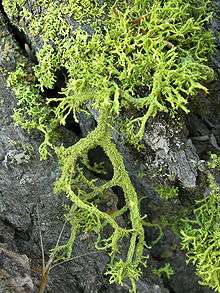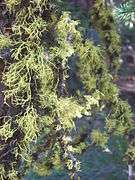Letharia vulpina
Letharia vulpina, commonly known as the wolf lichen (although the species name vulpina, from vulpine relates to the fox), is a fruticose lichenized species of fungus in the family Parmeliaceae. It is bright yellow-green, shrubby and highly branched, and grows on the bark of living and dead conifers in parts of western and continental Europe, the Pacific Northwest and northern Rocky Mountains of Western North America. This species is somewhat toxic to mammals due to the yellow pigment vulpinic acid, and has been used historically as a poison for wolves and foxes. It has also been used traditionally by many native North American ethnic groups as a pigment source for dyes and paints.
| Letharia vulpina | |
|---|---|
 | |
| Photographed in the San Gabriel Mountains, Los Angeles USA. | |
| Scientific classification | |
| Kingdom: | |
| Division: | |
| Class: | |
| Order: | |
| Family: | |
| Genus: | |
| Species: | L. vulpina[1] |
| Binomial name | |
| Letharia vulpina (L.) Hue (1899) | |
Description
The thallus, or vegetative body, has a fructicose shape — that is, shrubby and densely branched — and a bright yellow to yellow-green, or chartreuse color, although the color will fade in drier specimens. Its dimensions are typically 2 to 7 cm (0.8 to 3 in) in diameter.[2] The vegetative reproductive structures soredia and isidia are present on the surface of the thalli, often abundantly.

Physiology
Like most lichens, L. vulpina is highly tolerant of freezing and low temperatures. In one set of experiments, the lichen was able to reactivate its metabolism after 15 hours of cold storage and resume photosynthesis within 12 minutes of thawing. It was also able to start photosynthesis while rewarming, still at below-zero temperatures (°C), suggesting that it may remain active during winter.[3]
Distribution and habitat
L. vulpina occurs throughout the Pacific Northwest. It is often abundant on exposed branches that have lost their bark. In old, moist forests, it is typically found in drier areas.[2] This species has an intermediate air pollution sensitivity.[2] In the Rocky Mountains, Letharia species are found in ponderosa forests at the prairie-forest boundary at relatively low elevations though medium and high elevation Douglas fir and lodgepole pine forests.
Uses
Some Plateau Indian tribes used wolf lichen as a poultice for swelling, bruises, sores, and boils, and boiled it as a drink to stop bleeding.[4]
The brightly colored fruiting bodies are popular in floral arrangements.[2]
Dyeing
The Klamath Indians in California soaked porcupine quills in a chartreuse-colored extract of Letharia vulpina that dyed them yellow; the quills were woven into the basket patterns.[5]

Poison
The use of this species for poisoning wolves and foxes goes back at least hundreds of years, based on the mention of the practice in Christoph Gedner's "Of the use of curiosity", collected in Benjamin Stillingfleet, Miscellaneous Tracts Relating to Natural History, Husbandry and Physics (London, 1759).[6] According to British lichenologist Annie Lorrain Smith, reindeer carcasses were stuffed with lichen and powdered glass, and suggests that the sharp edges of the glass would make the animals' internal organs more susceptible to the effects of the lichen poison.[7] However, it is known that the lichen itself is also effective—powdered lichen added to fat and inserted into reindeer carcasses will also be fatal to wolves that consume it.[6] The toxic chemical is the yellow dye vulpinic acid, which is poisonous to all meat-eaters, but not to mice and rabbits.[6]
Similar species
The closely related Letharia columbiana lacks isidia and soredia, usually bearing instead apothecia.[2] It is also less branched than L. vulpina.[8]
Gallery
 Letharia growing with Bryoria sp. on pine branches near Blackpine Lake, Washington
Letharia growing with Bryoria sp. on pine branches near Blackpine Lake, Washington- Soredia and isidia are present in this species, however it lacks apothecia of Letharia columbiana.
 Magnified view (approximately 1 cm width) of a wolf lichen found near Mt Hood in Oregon.
Magnified view (approximately 1 cm width) of a wolf lichen found near Mt Hood in Oregon.
References
| Wikimedia Commons has media related to Letharia vulpina. |
- "Index Fungorum - Names Record". Retrieved 2009-01-20.
- Geiser, Linda; McCune, Bruce (1997). Macrolichens of the Pacific Northwest. Corvallis: Oregon State University Press. p. 148. ISBN 0-87071-394-9.
- Kallio P, Heinonen S. (1971). "Influence of short-term low temperature on net photosynthesis in some subarctic lichens." Reports of the Kevo Subarctic Research Station 8:63–72.
- Hunn, Eugene S. (1990). Nch'i-Wana, "The Big River": Mid-Columbia Indians and Their Land. University of Washington Press. p. 354. ISBN 0-295-97119-3.
- Hale, Mason E. (1983). The Biology of Lichens. London: E. Arnold. p. 138. ISBN 0-7131-2867-4.
- Galun, Margalith (1988). CRC Handbook of Lichenology, Volume III. Boca Raton: CRC. ISBN 0-8493-3583-3.
- Smith, Annie Laurie Wright (1975). Lichens. Richmond, Eng: Richmond Publishing Co., Ltd. ISBN 0-85546-192-6.
- "WSDOT - Ethnobotany - Lichens". Archived from the original on 2009-01-16. Retrieved 2009-01-21.